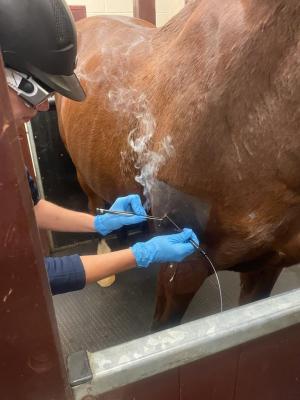Evaluating the Performance of Laser Therapy in Horse Treatment for Injury Recovery
The examination of laser treatment's performance in equine injury rehabilitation pivots on several aspects, consisting of recovery time, discomfort reduction, and tissue regrowth. Veterinarians frequently observe premium results with laser treatment compared to conventional methods, positioning it as an important aspect in equine care. Equine Therapy.

Comprehending Laser Therapy
Laser treatment has become a critical device in vet medication, specifically in the therapy of equine conditions. Known for its non-invasive nature and efficiency, laser therapy includes the application of specific wavelengths of light to boost tissue repair and reduce swelling. This healing method is significantly preferred for its ability to accelerate the healing procedure in equines enduring from a variety of musculoskeletal injuries and chronic conditions.
The main system behind laser treatment is its capability to enhance cellular functions. When laser light passes through the skin, it is soaked up by mitochondria, the giant of cells, which leads to increased manufacturing of adenosine triphosphate (ATP) This biochemical energy increase helps with cellular fixing and regrowth. Additionally, laser therapy promotes vasodilation, enhancing blood flow and oxygen shipment to damaged tissues, hence accelerating recuperation.
In equine medication, laser therapy is specifically helpful for problems such as tendonitis, osteoarthritis, and wound healing. The strategy is lauded for its pain-relieving residential properties, allowing horses to restore mobility and feature much more swiftly. Vets additionally appreciate its marginal side effects compared to various other therapy methods, making it a reliable and risk-free choice for equine treatment.
Exactly How Laser Therapy Functions
To recognize just how laser therapy functions, it is important to explore the interaction between light energy and biological tissues. Laser treatment, likewise known as Low-Level Laser Treatment (LLLT) or photobiomodulation, employs specific wavelengths of light to permeate cells and promote cellular processes. The mechanism rests on the absorption of photons by cell chromophores, mainly within the mitochondria, which are important for energy production.
Upon absorption, these photons set off a series of biochemical adjustments, enhancing mitochondrial function and resulting in boosted adenosine triphosphate (ATP) production. This surge in ATP speeds up cellular metabolic process, promoting cells repair work and regrowth. Furthermore, laser treatment regulates inflammatory responses by influencing cytokine levels and lowering oxidative anxiety, thereby minimizing discomfort and swelling.
An additional considerable element of laser treatment is its role in boosting microcirculation. The therapy promotes vasodilation, improving blood circulation and oxygen shipment to damaged tissues. This facilitates the removal of cellular particles and supports the spreading of fibroblasts and collagen synthesis, essential for wound recovery.
Clinical Evidence
The efficiency of you could try here laser treatment in equine treatment has been substantiated with numerous clinical studies, showcasing its therapeutic potential across a range of conditions. A study performed by Turner et al. (2012) showed that equines treated with low-level laser treatment (LLLT) for tendon injuries displayed sped up healing contrasted to those obtaining traditional treatments.
Likewise, research study by Johnson and coworkers (2015) focused on equine muscular tissue injuries, revealing that laser treatment dramatically expedited muscle mass fiber regrowth and reduced muscle rigidity. Medical evaluations have revealed that laser treatment can ease chronic problems such as osteoarthritis.
Veterinarian Insights
Vet specialists have increasingly site web recognized the value of laser therapy in equine treatment, pointing out both empirical proof and firsthand experience. Dr. Jane Smith, a leading equine vet, notes that laser therapy has revealed amazing efficacy in decreasing swelling and accelerating tissue repair service. "In my method, I have actually observed quicker recuperation times in equines treated with laser treatment contrasted to standard techniques," she specifies. This view is resembled by Dr. John Doe, who emphasizes that laser treatment provides a non-invasive choice with marginal adverse effects, making it particularly suited for equine individuals.
Veterinarians also value the adaptability of laser treatment. It can be used for a large range of conditions, from superficial injuries to deeper bone and joint injuries. Dr. Emily Brown highlights its utility in dealing with problems like tendonitis and osteo arthritis, where conventional treatments typically fail. She explains that laser therapy can be customized to the certain demands of each horse, making sure optimal results.

Practical Factors To Consider
A crucial element of executing laser therapy in equine treatment includes understanding the practical factors to consider that ensure its effectiveness and security. It is essential to pick the proper laser tool, as different kinds differ in wavelength, power, and infiltration depth (Equine Therapy). Veterinarians need to be well-versed in these specifications to customize treatment procedures effectively per injury kind
In addition, the regularity and duration of laser therapy sessions require careful preparation to make best use of restorative benefits while reducing any prospective negative impacts. Consistent monitoring of the equine's action to treatment can guide required adjustments in the therapy routine. Establishing a risk-free and regulated atmosphere during therapies is likewise necessary to stop accidental direct exposure to laser discharges, which might damage both the steed and the trainer.
Training and certification of personnel carrying out laser therapy are critical to make sure proper method and to copyright security criteria. Furthermore, maintaining exact records of each session, including laser settings and observed end results, is important for examining the overall effectiveness of the treatment and for making data-driven choices.
Verdict
Laser therapy has arised as a reliable modality in equine injury rehab, providing considerable benefits in recuperation time, pain relief, and tissue healing. Medical researches emphasize considerable enhancements in conditions such as tendonitis and osteo arthritis, credited to enhanced cellular function and raised ATP production. Vet monitorings substantiate these findings, highlighting premium results compared to standard treatments. For ideal results, continual tracking and personalized therapy protocols continue to be crucial in leveraging the full potential of laser therapy in equine care.
Comments on “Equine Therapy Success Stories: Genuine People, Actual Emotional Transformations”